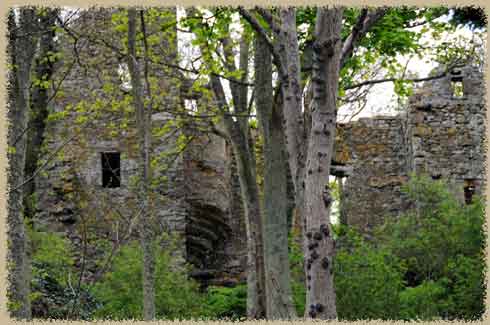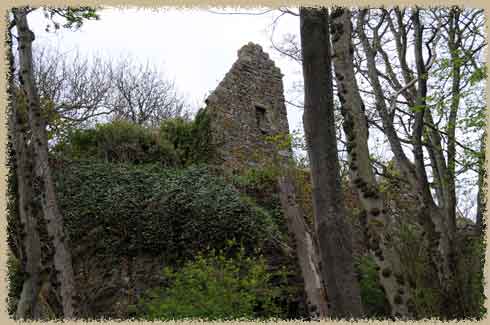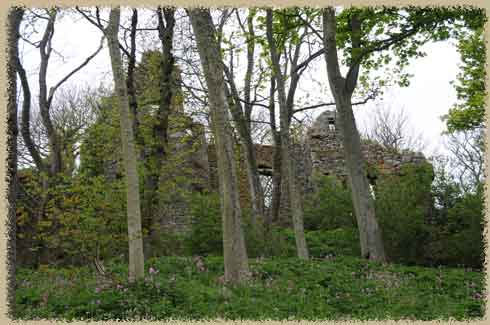Auldhame Castle
We drove down to Auldhame Beach -- in search of the elusive castle here. I nearly slid on my butt all the way down to the bottom of the huge hill (oh, so helpfully made into a muddy mess by horses, to judge by the hoofprints). It's a steep climb, and when I spied the remains of Auldhame castle up on the ridge, I spent about three seconds thinking about it before I realized that I had no idea how to get up there -- and even if I did, I'd probably kill myself. Mark took off to look at Seacliff beach and the tiny harbor there, while I maneuvered around looking for good angles to get photos.

the mostly-hidden remains of the tower house
16th Century L-Plan tower
The castle is actually quite sizeable, and it's perched high on the ridge. The main block has three stories, and a stair tower -- a corbelled out bartizan in the corner can be spied easily from below. The side facing the beach is complete and in good condition, while the landward side is mostly ruined (good thing I only have pictures of the "good" side, then!)
Inside, the callar if vaulted, and contains a kitchen with a wide fireplace and ovens. The main tower is 18m x 8.3m, with a wing on one end and another in the middle of the east side (the only visible bits). The south wing is missing. There are two doorways on the western end with a shared bar slot (like Carnasserie?).
Unusually, the walls on the east side may have originally been much thinner, and added to later to make them thicker--the doors and windows splay both in and out, instead of being flush with the outside walls.
The stone rubble construction of the castle was harled (as were nearly all castles) and notes suggest that it was a pale yellow color. The pastel-like colors of harling that show up on a number of restored castles (pink, salmon, butter yellow, pale cream) are the result of investigatio ninto the original colors, of course -- faint bits of original harling, recipes, and descriptions were used to develop the colors. They're actually quite festive, but sometimes they are shockingly bright when compared to the plain stone that we're used to seeing (see the Great Hall at Edinburgh for an example!)
No other buidlings remain on the site, but there are remains of an orchard and even of a graveyard nearby (sans headstones) -- some have even suggested taht thsi might be a church building of some sort. Perhaps the first Whitekirk church was on this site and incorporated into the existing castle? (The current parish church is further inland, moved there to avoid raids on the coast).

a clearer view of the gabled end of the south wing
Ownership
The land here was originally part of a church estate belonging to the parish of Whitekirk. . It was bought by Adam Otterburn (Provost of Edinburgh), around 1559, and he probably built the first castle here on the site. At that time, the castle would have been part of Auldhame Village, although the village and the origianl church are long gone.
The history of the castle and its ownership pale in comparison to the massive and magnificent Tantallon, which can be seen from the beach below. It was probbaly a sidenote to the battles that took place at its grander cousin, possibly even occupied during the bombardemenet of Tantallon in 1651 by Cromwell. It wasn't mentioned, of course, but the location is auspicious.

the eastern face of the castle is almost intact

